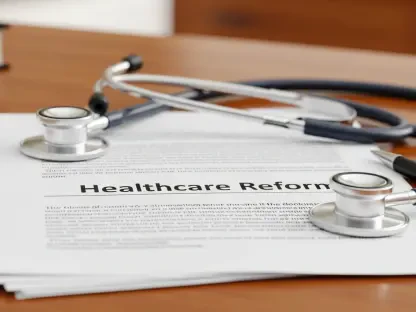As we dive into the complexities of the US healthcare system, I’m thrilled to sit down with Faisal Zain, a renowned expert in health policy with a deep background in medical technology and innovation. With years of experience in shaping healthcare solutions through cutting-edge diagnostics and treatment devices, Faisal brings a unique perspective on how policy and technology intersect to impact patients and providers. In this conversation, we explore the critical issues surrounding Medicaid expansion, the challenges of a profit-driven healthcare model, gaps in coverage, and potential pathways to a more equitable system. Join us as we unpack these pressing topics and envision a better future for healthcare in America.
How did the recent forum at Meredith College aim to address the challenges within Medicaid, Medicare, and the private insurance market?
The forum, hosted by the North Carolina Institute of Public Leadership, was designed to shed light on how these three pillars of our healthcare system impact North Carolinians. The main goal was to foster a deeper understanding of policy effects, particularly around Medicaid expansion, and to spark dialogue on creating more sustainable and equitable healthcare solutions. It brought together diverse voices to discuss real-world outcomes for patients and communities, emphasizing the need for reform in a system that often prioritizes profit over care.
What unique insights did the panelists bring to the discussion on the US healthcare system?
The panel was a powerhouse of perspectives, blending legislative expertise with on-the-ground policy analysis. We had state representatives who understand the political hurdles of healthcare reform, alongside health policy consultants who’ve navigated the intricacies of legislation over the years. Their combined insights offered a well-rounded view of both the systemic barriers and the opportunities for change, especially in how policies like Medicaid expansion play out at the state level.
Can you elaborate on how Medicaid expansion has been a lifeline for patients in states like North Carolina?
Absolutely. Medicaid expansion has been transformative by widening access to healthcare for low-income individuals who previously couldn’t afford coverage. It’s meant that more people can see a doctor without the fear of crippling debt, ensuring they get timely care for chronic conditions or emergencies. This access directly translates to better health outcomes, as patients are no longer delaying treatment until their conditions worsen, which is a huge win for overall public health.
In what ways has Medicaid expansion specifically supported rural communities facing financial strain?
Rural communities have been hit hard by uncompensated care costs—basically, the bills hospitals rack up when patients can’t pay. Medicaid expansion has alleviated this burden by covering more individuals, which means hospitals get reimbursed for services they provide. This financial relief helps keep rural hospitals open, ensuring that these communities aren’t left without critical care options, which is often a matter of life and death in remote areas.
Why is the low out-of-pocket cost structure of Medicaid so crucial for encouraging preventative care?
When out-of-pocket costs are low, people aren’t deterred from seeking care early on. High costs often lead folks to skip routine check-ups or delay seeing a doctor until a problem becomes severe. Medicaid’s structure removes that financial barrier, encouraging individuals to establish relationships with primary care providers and get screenings or vaccinations that can catch issues before they escalate, ultimately improving health and reducing long-term expenses.
Could you share some examples of preventative services covered by Medicaid and their impact on cost savings?
Sure, Medicaid covers a range of preventative services like annual physicals, cancer screenings, immunizations, and even prenatal care. These services help detect conditions like diabetes or hypertension early, which can be managed with relatively inexpensive interventions. By preventing progression to more serious stages that require hospitalizations or surgeries, these measures save the system—and taxpayers—significant amounts of money over time.
What are some of the biggest challenges people face with rising healthcare costs, particularly around deductibles and out-of-pocket expenses?
Rising costs are creating a real crisis for many Americans. Higher deductibles and out-of-pocket expenses mean that even insured individuals hesitate to seek care because they can’t afford the upfront costs. This financial strain often forces tough choices—like skipping necessary treatments or medications—which can worsen health conditions and lead to even higher costs down the line. It’s a vicious cycle that’s hard to break without systemic change.
How does a profit-centered healthcare model in the US create barriers for patients seeking care?
A profit-driven system often puts financial gain above patient needs. This can manifest as denied claims, limited coverage for essential treatments, or inflated prices for services and medications. Providers and insurers may prioritize procedures or plans that yield higher returns rather than focusing on what’s best for the patient, leaving many struggling to access the care they need and fostering distrust in the system.
How does the extent of profit allowed in the US healthcare system compare to other developed nations, and what are the consequences?
Unlike many developed nations where healthcare is treated more as a public good with strict regulations on profit, the US allows far greater financial incentives in the sector. This leads to inefficiencies and disparities—our system spends more per capita on healthcare but achieves poorer outcomes like lower life expectancy. The focus on profit inflates administrative costs and prices, diverting resources from actual care and leaving gaps for many Americans.
What does it mean to describe the US healthcare system as bloated and overcomplicated, and can you provide some examples?
Calling the system bloated and overcomplicated points to the layers of inefficiency and bureaucracy that drive up costs without improving care. For instance, the complex billing and insurance processes create a massive administrative burden—hospitals and clinics spend enormous resources just navigating claims. Additionally, the patchwork of coverage options means patients often fall through the cracks, facing denied services or unexpected bills due to unclear policies.
Why are poor health outcomes, such as high maternal and infant mortality rates, linked to the structure of the US healthcare system?
These poor outcomes are tied to systemic issues like unequal access to care and the prioritization of profit over prevention. Many Americans, especially in underserved communities, lack consistent access to prenatal or primary care, which is critical for maternal and infant health. When care is delayed or denied due to cost or coverage issues, preventable complications arise, contributing to these alarming statistics compared to other developed countries.
What are some of the key gaps in health coverage that surfaced during discussions on Medicare policies?
One major gap is that Medicare doesn’t cover everything—things like long-term care, dental, vision, and hearing aids often aren’t included, leaving seniors with significant out-of-pocket costs. There’s also the issue of the “donut hole” in prescription drug coverage, where beneficiaries face a coverage gap after spending a certain amount. These gaps mean that even with Medicare, many older adults struggle to afford comprehensive care.
Can you explain the concept of a single-payer system and why it’s often proposed as a solution to current healthcare challenges?
A single-payer system means the government acts as the primary insurer, covering healthcare costs for all citizens through taxes rather than a mix of private and public plans. It’s proposed as a solution because it could streamline administration, reduce costs by eliminating profit-driven middlemen, and ensure universal coverage. The idea is to prioritize patient care over financial gain, making healthcare a right rather than a privilege.
How might a single-payer system balance the needs of healthcare providers with fair reimbursement rates?
The key is setting reimbursement rates that are sustainable for providers while controlling overall costs. In a single-payer system, negotiations could ensure that doctors and hospitals are compensated fairly based on the value of services, not inflated market prices. It would also reduce the administrative hassle of dealing with multiple insurers, allowing providers to focus on care rather than paperwork, which could offset any potential reduction in individual payments.
What is your forecast for the future of healthcare reform in the US, especially regarding universal coverage?
I think the push for universal coverage will continue to gain momentum, driven by growing public frustration with the current system’s inequities and costs. While a full shift to a single-payer model may face political hurdles in the near term, we’re likely to see incremental steps like expanded public options or broader Medicaid access in more states. Technology will also play a bigger role in making care more efficient, but the core challenge remains building political will to prioritize health over profit. I’m cautiously optimistic that over the next decade, we’ll move closer to a system where no one is left behind.









